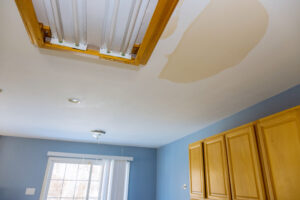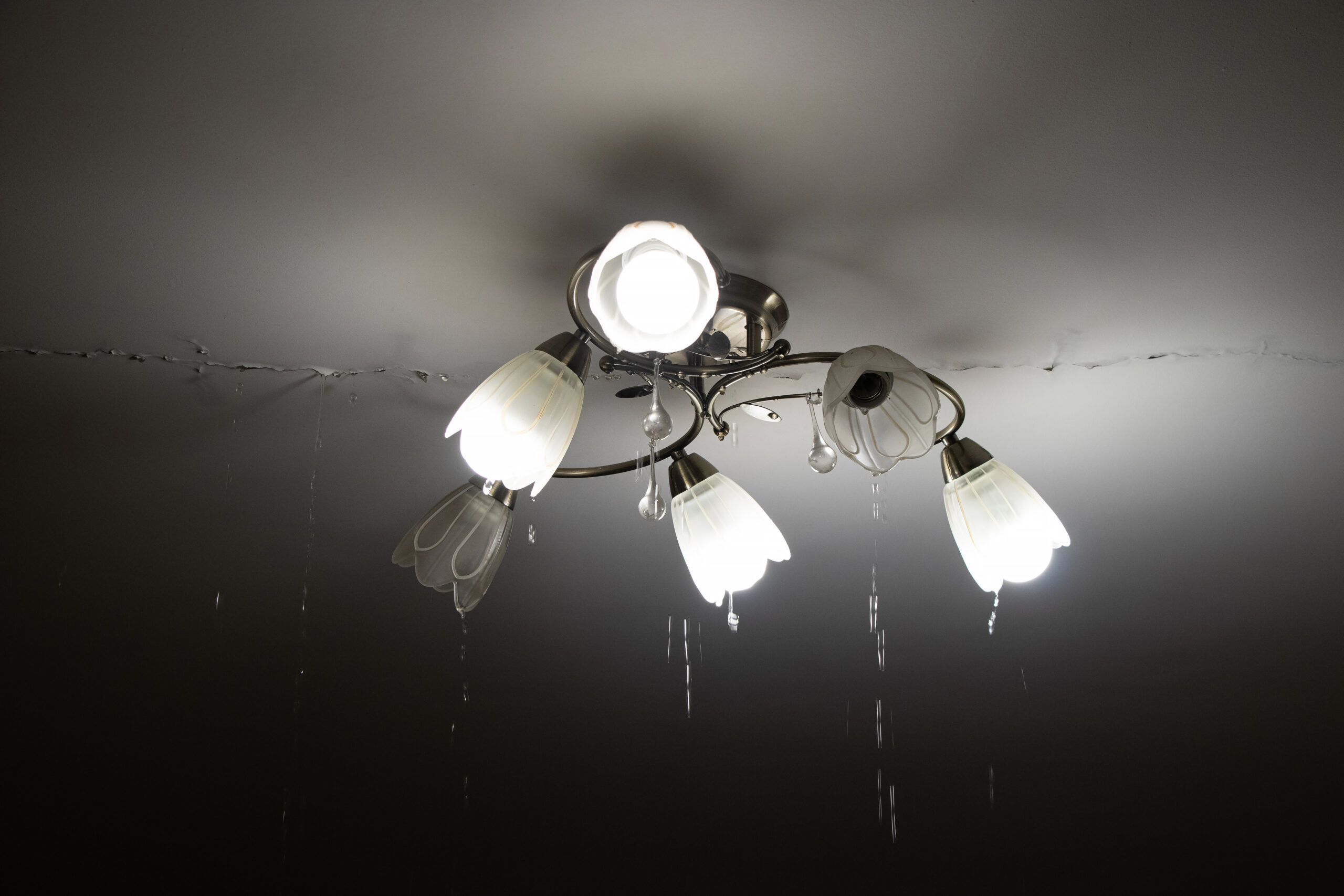TL;DR:
If water is leaking from a ceiling light, turn off the power immediately at the breaker, then shut off your home’s main water supply. Stay away from the area, call a licensed plumber and electrician, and document any damage for insurance.
Once fixed, dry the space quickly to prevent mold. Common causes include plumbing leaks, HVAC condensate backups, roof issues, or faulty bathroom fixtures. Regular inspections and maintenance can help prevent future leaks.
Water leaking from a ceiling light fixture is one of the most dangerous home maintenance emergencies you can face. It’s not just a water issue—it’s also a critical electrical hazard. In a city like Houston, where humidity, storms, and plumbing wear and tear are common, this situation requires swift action to protect both your property and your safety.
Whether you notice a steady drip or an active stream coming from a ceiling light, the correct response can prevent electrical shock, fire hazards, structural damage, and mold growth.
Step 1: Shut Off Power to the Affected Area
The very first step is to cut off electricity to the area where the leak is occurring. Go to your circuit breaker panel and turn off the power to that section of the home. If you aren’t sure which breaker controls the affected light, turn off the main breaker to ensure complete safety.
Do not touch the light fixture, wall switches, or any wet surfaces. Water conducts electricity, and you could be seriously injured or worse by coming into contact with an energized, wet fixture.
Step 2: Shut Off Your Home’s Water Supply
If the water appears to be flowing or dripping continuously, locate your main water shut-off valve and close it to prevent further water damage. In Houston homes, the main water valve is typically found:
- Near the water heater
In the garage or utility area
- Outside, along the home’s perimeter
- In a water meter box near the street
Stopping the water flow will reduce the extent of the damage and help your plumber quickly locate the source of the problem.
Step 3: Stay Clear of the Affected Area
Even with the power off, do not attempt to remove or inspect the light fixture yourself. Hidden wires may still carry residual voltage, and the fixture may be unstable due to water damage. Avoid walking in standing water near electrical components and keep pets and children away from the area until professionals arrive.
Step 4: Call a Licensed Houston Plumber and Electrician
Once the immediate hazards are contained, it’s time to call in professionals. You will likely need both a licensed plumber to diagnose and fix the water leak, and an electrician to assess and repair any electrical damage.
If you’re in the Houston area, Power Plumbing Services offers rapid emergency response and experienced technicians who can handle complex leaks and coordinate with electricians. Fast, local help is key to minimizing water damage and ensuring your home is safe.
Step 5: Document the Damage for Insurance Claims
Take clear photos and video of:
- Water dripping from the fixture
- Ceiling discoloration and sagging
- Water-damaged flooring or furniture
- Any visible structural issues
This documentation can be vital for insurance claims, especially if restoration work is required. Be sure to keep receipts for all repairs and remediation services.
Step 6: Begin the Drying and Restoration Process
Once the source of the leak is repaired and your electrical system has been inspected and deemed safe, begin drying out the area immediately. Use high-powered fans, air movers, and dehumidifiers to remove moisture from:
- Drywall and ceilings
- Insulation (which may need to be removed)
- Subflooring and carpets
- Cabinets and furniture
Houston’s humidity makes mold growth a serious concern. Mold can begin forming within 24 to 48 hours of water exposure. In cases of significant water intrusion, consider hiring a professional water damage restoration company to ensure thorough drying and prevent long-term issues.
Common Causes of Water Leaking Through Ceiling Light Fixtures
Understanding what could be behind the leak can help you prevent future problems. Here are the most common causes of water leaking through a light fixture in Houston-area homes:

1. Leaking Plumbing Lines
Water supply or drainage pipes running through ceilings may develop leaks due to:
- Age and corrosion
- Pipe bursts during temperature fluctuations
- Faulty installation or loose fittings
- Foundation shifting (a common issue in Houston’s clay soil)
If there’s a bathroom, laundry room, or kitchen above the affected light, plumbing issues are likely the culprit.
2. HVAC Condensate Line Backups
In Houston’s hot and humid climate, air conditioners produce large amounts of condensation. If the condensate drain line is clogged or disconnected, water can pool in the ceiling and leak through light fixture openings.
3. Roof Leaks
Damaged or aging roofing materials allow rainwater to enter attic spaces and ceilings, particularly during Houston’s frequent storms and hurricane season. Poor flashing, broken shingles, or clogged gutters can all direct water where it doesn’t belong.
4. Faulty Bathroom Fixtures Above
If there’s a bathroom above the leaking light, the issue may stem from:
- A leaking shower pan or bathtub
- Loose tile or missing caulk
- A faulty toilet seal
- Overflow incidents from bathtubs or sinks
5. Exterior Water Intrusion
Water can also seep in through poorly sealed windows, gaps in siding, or wall penetrations. In multi-story homes, improperly routed downspouts can direct water into the structure, where it travels to ceiling fixtures.
How to Prevent Water from Leaking Through Light Fixtures
Once you’ve resolved the immediate emergency, take proactive steps to reduce the risk of it happening again.
Schedule Regular Plumbing Inspections
Hire a Houston-based plumber to inspect your plumbing system annually. Preventive maintenance can catch corrosion, joint failures, and pressure issues early.
Maintain Your HVAC System
Ensure your condensate line is cleaned and flushed regularly to prevent clogs. Replace or repair overflow pans when necessary.
Inspect Roof and Gutters
After heavy rain or storm events, inspect your roof, flashing, and gutters for signs of damage. Schedule professional roof inspections at least once a year.
Upgrade Fixture Seals and Waterproofing
Ensure bathrooms are adequately sealed and caulked, especially around tubs, showers, and sinks. Consider upgrading older fixtures and waterproof membranes in upstairs bathrooms.
Install Smart Leak Detection Devices
Place water leak detectors in bathrooms, under sinks, and near water heaters. These devices can send alerts to your phone when they detect moisture, allowing you to respond before damage spreads.
Why Houston Homeowners Trust Power Plumbing Services
At Power Plumbing Services, we understand the critical importance of fast, skilled help when your ceiling starts leaking water—especially when it’s coming through a light fixture. With years of experience serving Houston homeowners, we offer:
- 24/7 emergency response
- Licensed and insured professionals
- State-of-the-art leak detection tools
- Coordination with trusted local electricians
- Upfront pricing and guaranteed work
We’re not just plumbers—we’re your partners in home protection. Whether you live in Midtown, the Heights, Sugar Land, or any part of the Greater Houston area, we’ll get to you fast and solve the problem the right way.

